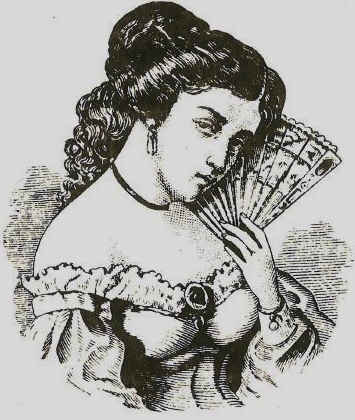The forgotten tale of a Bristol beauty and the exiled king of Spain.
He lived in a palace on a hill in Bordentown, N.J. She resided across the Delaware River in a waterfront mansion in Bristol. He was the former king of Spain, the elder brother of European Emperor Napoleon Bonaparte. She was a golden-haired, blue-eyed vision of pulchritude who once danced with royalty in England and turned heads wherever she went. Though he was in his late 40s and she in her early 20s, Sarah and Joseph appeared to be destined for one another.
Sarah Lukens Keene was born in 1788 and raised by her aunt and uncle, U.S. Army Major David and Tracy Lenox in their 3-story stone edifice on North Radcliffe Street. Sarah, extraordinarily attractive, was wildly popular with a captivating personality. When her uncle was appointed U.S. attache in London, she danced with the Prince of Wales who termed her “the American beauty.”

In Bristol, she was fond of riding in the family’s horse-drawn carriages with seats fashioned in light blue cloth with gold and white cording. Young men came calling, among them Philadelphia banker Nicholas Biddle who later wrote, “Time was when to see thy fair Lady alone would awake into verse this cold bosom of stone.”
It was handsome Col. John Powell who proposed to her. Sarah deferred to Aunt Tracy for approval. She wouldn’t give it. “Mr. Powell,” she began, “you ask my consent to your marriage with my niece. My answer is Miss Sarah L. Keene is intended for the son of a duke or a lord, and not for the son of a brewer.”
Enter Joseph Bonaparte. Portly and the visage of imprisoned brother Napoleon, Joseph had abdicated the Spanish throne and fled with his riches to New York. In Trenton, he persuaded the Legislature to amend state law so he could buy 1,000 acres between the capital and Bordentown to the south. There overlooking the Delaware and Crosswicks Creek he built a dazzling white, three-story palace decorated with statuary and oil paintings by European masters. French gardens and woodlands offered 12 miles of walking and riding trails.
Bonaparte invited tours of Pointe Breeze. Henry Clay, Daniel Webster, John Adams and local citizens were among his many visitors. On one occasion, he escorted author Helen Berkeley and a female companion around his home. They witnessed secret passages, hidden doorways, sliding bookcases and pop-out drawers stuffed with emeralds, diamonds and gold. The two were shocked at nude paintings and ceiling-to-floor mirrors including one above Bonaparte’s bed. Their host who was known for scandalous affairs with American mistresses fawned over a reclining nude statue of his sister Pauline. “He stood some time perfectly enraptured before it, pointing out to us what a beautiful head Pauline had, what hair, what eyes, nose, mouth, chin, what a throat, what a neck, what arms, what a magnificent bust, what a foot, enumerating all her charms, one after another, and demanding our opinion of them,” reminisced Berkeley. “We were obliged to show as much sang-froid on the subject as himself, for it was impossible to get him away without our prudery exciting more attention than would have been pleasant.”

Invited to the Lenox mansion, Bonaparte caught the eye of the lovely Sarah. He became a frequent guest, arriving by elegant horse-drawn coach from Trenton or his royal barge manned by six oarsmen and flying the American and tri-color French flags. Rumors of a budding romance swirled. It perhaps crossed Aunt Tracy’s mind this was the “duke or lord” she had been hoping for her niece. But it was not to be. Chemistry between the two never quite jelled. Besides, he was married.
After a stay of 16 years, Bonaparte returned to wife Julie in Europe in 1832. He died 12 years later in Florence, Italy. His grandson disposed of Pointe Breeze. Henry Beckett, British consul in Philadelphia, purchased the property in 1850 and leveled the palace. Over the years the estate fell to ruin, with only a tree-lined Bordentown walkway and memorial left to tell its story.
Across the river, Sarah Keene never married, living out her life in Philadelphia. According to many accounts, the chief engraver for the Philadelphia Mint saw her put on an Indian war bonnet at a reception. That inspired James Longacre to use her as the model for the Indian head penny in U.S. currency.
At her passing, Sarah willed her Lenox mansion to the Episcopal Church as a home for poor widows. To Bristolians, it seemed a haunted place after it fell into disuse, spooking area children. In 1964, the desolate building was torn down for today’s esteemed Margaret R. Grundy Memorial Library. In the end, all was gone – Sarah’s mansion and Joseph’s palace – leaving only dusty memories of the American beauty and the Spanish king.
Sources include “Historic Houses of New Jersey” by W. Jay Mills published in 1902; “Godey’s Lady’s Book” by Helen Berkeley published in 1845; “The Gentle Bonaparte” by Owen Connelley published in 1968; and “Keene Home and Its Once Famous Mistress” published on Feb. 28, 1917 in the Bristol Courier newspaper. Also thanks to Alan Vogenberg and Grundy Library archivist Eric Walerko for their help.
Carl LaVO, a retired Courier Times editor, can be reached at [email protected]. He will discuss the story of Castle Valley at the Doylestown Historical Society at 7 p.m. Thursday (Sept. 28) in the Syd & Sharon Martin Barn, 56 S Main St,, Doylestown, Afterwards, LaVO will sign copies of his new coffee table book“Bucks County Adventures”.

